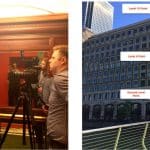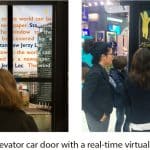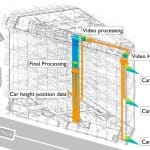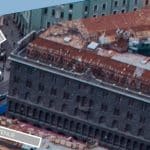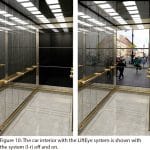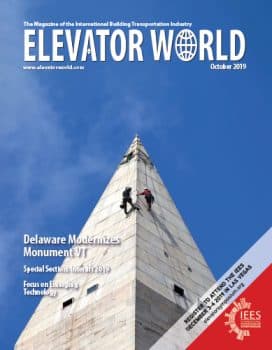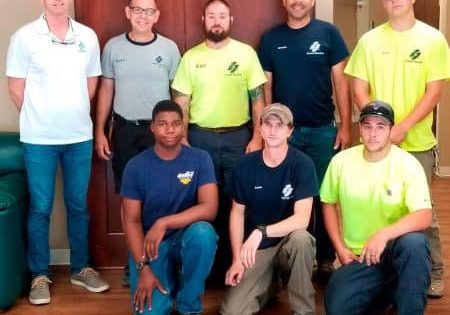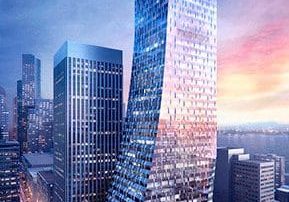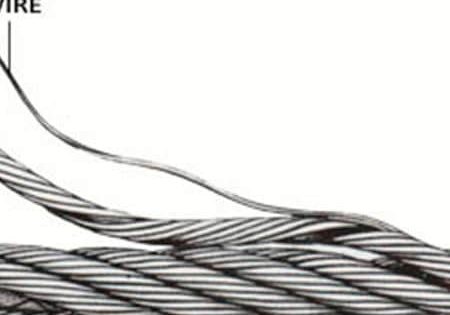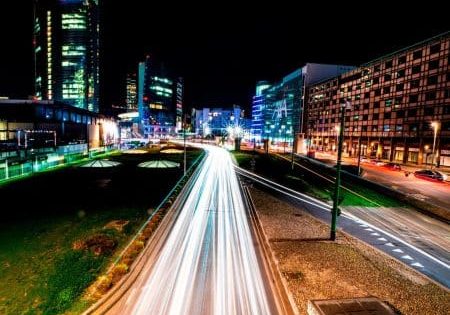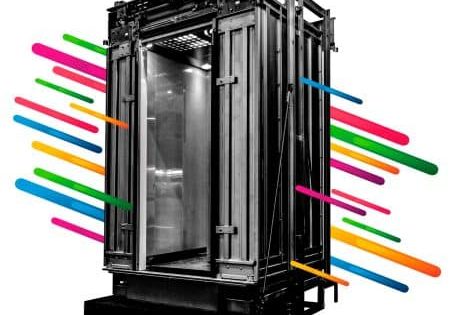This Product Spotlight highlights a lifelike virtual elevator window system designed to transform the passenger experience.
The elevator cars we’ve been using are more like closed transportation boxes than elements of architectural experience. With their lack of visual stimulation, a ride in a conventional elevator is often an awkward interruption of an otherwise enriching experience offered by the architecture of public and residential buildings. A glass-walled elevator car provides an ideal solution to that disruption but is not feasible in most instances and often entails extra costs. As a result, the floor indicator, supplemented in some advanced cases with cartoons, has become the typical feature used to inform passengers of their current position.
A lifelike virtual elevator window system, designed to transform the passenger experience, was released six years ago at Interlift and gradually found a niche in sophisticated elevators for upscale buildings. The technology relies on the precise calculation of every pixel and offers a real-time picture of the outside view, combined with augmented reality and contextual information. Modern trends of visualization employed in elevator cars, including virtual windows, vary in degrees of image quality, positioning accuracy and lag. The LiftEye, Ltd. Real Time Virtual Window provides user-friendly elevator design with promising advertising potential and an almost universal navigation tool for visitors of public buildings. It offers real-time picture technology in a recently emerged and rapidly growing family of virtual windows and video walls in elevators all over the world.
New Typology and the Virtual Windows Box
The dramatic progress in design, feasibility and availability of widescreen displays in recent years led the industry to widespread implementation of monitors in elevator cars. Let us refer to these large flat screens in elevator cars as “virtual windows.” This type of installation enables visual stimulation of passengers by offering entertainment content, advertisement videos, emergency announcements, news feeds and, last but not least, navigation cues. Well-known showcase boxes, which may still be found in some hotel elevators, became the early predecessors of virtual windows, while small displays built into the operating panels were their immediate precursors.
Numerous examples of virtual-window-equipped elevator cars constitute an original elevator typology in which the visual stimulation of passengers is a primary distinction. To compare known cases of virtual windows, the LiftEye team introduced a 3D diagram called the “Virtual Window Box”[1] (Figure 1). The cases are aligned in space with axes X, “Actual Environment Reflection Degree”; Y, “Adjustment to the Height Position” (i.e., adjustment of the viewer in the elevator car to the actual height position to the performed perspective); and Z, “Time Lag 1/τ” (inverted scale of time lag, τ). You may come across various cases, from still patterns/pictures on elevator car walls (or just painted ones), to animated cartoons depicting fictional environments displayed on walls (or the ceiling), all the way up to real-time virtual windows mounted on car walls or doors.
The location of the conventional car with non-transparent walls (“still pattern”) and the panoramic “glassy car” are in Figure 1 marked as yellow ovals. The glassy car represents a case in which an elevator passenger can view the actual environment with an accurate perspective and in real time (τ = 0). The visual stimulation in the glassy car seems almost perfect.
The obvious disadvantage of panoramic elevators is their limited feasibility due to building structural issues and, thus, relatively high associated costs. Those limitations force the developers to opt for video walls (One World Trade Center (WTC) in NYC) and ceilings (The Shard in London) in lift cars paired with non-real-time content.
The majority of known virtual windows offer little to no reflection of the outside reality. On the chart, those installations remain a horizontal surface at bottom (τ = ∞). In most cases, the performance of those virtual windows depends on the actual position of the car (Y-axis): “The Ceilings of London” (The Shard); “The History of New York” (One WTC, NYC); and, the multiscreen show (Lotte Tower, in Seoul, South Korea). The content of those virtual windows (or ceilings) does not reflect the outside world “as it is.” We believe those virtual windows are fitting for one-time visitors but not for residents. It is hard to believe someone would enjoy the same content over and over again.
A real-time picture (τ ≥ 0) offers the solution to overcome the one-time visitor experience as described in U.S. Patent No. 9,571,798 (Figure 2). The proposed device renders a live image with the correct height perspective. A working prototype of that device, with one wide high-definition (HD) display, was introduced in October 2013 in Augsburg, Germany (Figure 3).[2 & 3] Only two HD cameras were utilized to provide the real-time feed. They were mounted on the outer wall of the building with the elevator as shown.
When a real-time feed becomes available from cameras set in other locations, elevator users may switch the image to that feed. This feature might be attractive for such businesses as hotel chains and office buildings.
At the “Virtual Windows Box” (Figure 1), a real-time virtual window is presented as case A, placed very close to the “glassy car” point at the rear, right-hand top corner. The proximity of “A” to “glassy car” is limited by the time it takes to process the real-time image feed and may be further affected by a lag in the communication channel between the main building and the source.
The basic requirement for the software is to exclude delays in computing the vertical position, especially during acceleration and deceleration, to prevent motion sickness. The ability to render virtual window pictures in high resolution is paramount. The feedback from the 2013 Augsburg LiftEye installation confirmed that passengers, being close to the walls, didn’t find full HD/1080p (1920 X 1080) displays comfortable due to the relatively large size of the pixels.
Ultra-high-definition, or UHD-1/2160p (3840 X 2160, also known as 4K), displays are preferable in this case. The overall cost of the system is higher because of the higher price of UHD cameras and higher computational requirements (both hardware and software).
The temporary installation of a UHD real-time virtual window (Figure 4) in London (May 2015) became a trial of UHD cameras, software and display as a set.[4]
LiftEye introduced elevator car doors with real-time virtual windows in 2015. (Figure 5). This system is equipped with four wide UHD displays.[5] The door is compatible with EN 81-20 and suitable for new lifts, as well as for the replacement of car doors of any brand. A detailed comparison of LiftEye (Figure 1, Case A) and the installation in One WTC (Figure 1, Case C) is provided in Figure 6.
Both LiftEye car-wall and door installations received positive feedback from the international press, with such comments as it “makes it look like the walls are made of glass”[6] and “You can get a view of the . . . New York skyline in Berlin.”[7 & 8] LiftEye was also nominated for the Council on Tall Buildings and Urban Habitat Best Tall Buildings Innovation Award.[3]
Wawelberg Bank Building Project
A recent LiftEye real-time virtual window project is designed for one of the new elevators in the Wawelberg Bank Building in downtown St. Petersburg, Russia. This historic building is now under renovation and is scheduled to open next year as a luxury hotel. The scheme, shown in Figure 7, illustrates the allocation of LiftEye hardware in the building. The system is equipped with two sets of UHD cameras. Each set of three cameras looks in opposite directions along the main city avenue, Nevsky Prospect.
The UHD video feed collected from the cameras is transmitted via a video hub to the video-processing unit for calculation of a 3D, real-time panorama. The information is transmitted via an elevator traveling cable into the final processing unit on the elevator car roof, where the picture is finally modified by actual- height position data and displayed on three UHD monitors on the car walls.
At the special request of the building owner, outdoor cameras are utilized for this particular project, instead of the typical LiftEye indoor units. Their cases are individually manufactured to meet strict requirements of the City Committee for Preservation of Historical and Cultural Monuments (Figure 8).
The outstanding location of the building (upper right, Figure 9), right around the corner from the Winter Palace, a former residence of the Russian royal family and today home of a
world-class art collection of The Hermitage museum, is the perfect place to engage LiftEye’s featured augmented reality, smart advertising and news feed. This includes not only the weather report and forecast (essential for anyone about to walk outside with the often-unpredictable heavy rains), but a connection to the city itself. The elevator is equipped with three UHD monitors, and the design of the car provides protection for monitors, effective heat emission and easy maintenance and cleaning.
Limitations
Privacy issues in many countries may prevent installation of real-time virtual windows in any form, so specific measures, such as blurring of human faces and car license plates, should be taken. Data channel capacity limitations between the lift and a distant location, from where the real-time feed must be transmitted, may dramatically reduce the overall performance of real-time virtual windows. Some quasi-real-time solutions are known and may be employed.
Conclusion
We believe virtual windows and real-time image feeds will also prove to be a prime navigational tool for future lifts with linear motors, which move people vertically and horizontally.
The lifelike real-time virtual elevator window system is designed to transform the passenger experience by providing user-friendly elevator design with visual stimulation — the “big picture” of what is currently available in the recently emerged and rapidly growing family of virtual windows and video walls in elevators all over the world. Your authors hope readers will repeat the phrase from the U.K. band London Grammar: “Now I see the big picture.”
- Figure 1: The Virtual Windows Box
- Figure 2: U.S. Patent No. 9,571,798
- Figure 3: (l-r) Cameras used in 2013 introduction of a real-time feed; visitors watch a demonstration of the system.
- Figure 4
- Figure 5: LiftEye’s elevator car door with a real-time virtual window.
- Figure 6: Real-time versus time-lapse feed
- Figure 7: The allocation of LiftEye hardware in the Wawelberg Bank Building
- Figure 8
- Figure 9: An aerial view of the Winter Palace and Palace Square in St. Petersburg, Russia; photo by Andrew Shiva via Wikipedia
- Figure 10: The car interior with the LiftEye system is shown with the system (l-r) off and on.
References
[1] Gorilovsky, Aleksey and Gorilovsky, Dmitry: “Elevators: Continuity & Enrichment of Architectural Experience in Times of Fictional Architecture,” Connecting the City. People, Density & Infrastructure. Abstracts of the CTBUH 2017 International Conference 29 October-3 November, 2017 Sydney, Melbourne & Brisbane. Editors: Antony Wood, Helen Lochhead, Philip Oldfield & Jason Gabel, Chicago: Council on Tall Buildings and Urban Habitat, p.223, ISBN 978-0-939493-58-6.
[2] Gorilovsky, A., Gorilovsky, D., and Langley, P.: “Elevators: Continuity and Enrichment of Architectural Experience.” CTBUH Shanghai Conference, p. 864-870 (2014).
[3] CTBUH. “Innovation Award Nominee: LiftEye,” Best Tall Buildings: A Global Overview of 2014 Skyscrapers. Editors: Antony Wood, Steven Henry and Daniel Safarik, IIT, Tongji University and Routledge/Taylor & Francis, Chicago, p. 224-225 (2014).
[4] Giving Lifts a Live Virtual Window: BBC Click’s Dave Lee Reports, bbc. in/1S0eKK9, (May 18, 2015); last accessed August 15, 2019.
[5] www.youtube.com/watch?v=0awDzIZyUT4; last accessed August 14, 2019
[6] en.wikipedia.org/wiki/Elevator; last accessed August 14, 2019.
[7] www.ribaj.com/products/multi-national-multi-storey; last accessed August 14, 2019.
[8] www.fastcoexist.com/3028539/this-elevator-might-make-you-forget- youre-stuck-in-a-metal-death-trap-with-strangers; last accessed August 14, 2019. lifteye.com
Get more of Elevator World. Sign up for our free e-newsletter.



